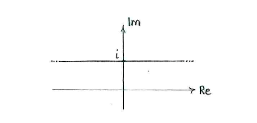Solution 3.2:2e
From Förberedande kurs i matematik 2
(Difference between revisions)
m (Robot: Automated text replacement (-[[Bild: +[[Image:)) |
m |
||
| (2 intermediate revisions not shown.) | |||
| Line 1: | Line 1: | ||
| - | { | + | Because the expression contains both <math>z</math> and <math>\bar{z}</math>, we write out <math>z=x+iy</math>, where <math>x</math> is the real part of <math>z</math> and <math>y</math> is the imaginary part. Thus, we have |
| - | < | + | |
| - | {{ | + | :*<math>\mathop{\rm Re}z = x</math> |
| + | :*<math>i+\bar{z} = i+(x-iy) = x+(1-y)i</math> | ||
| + | |||
| + | and the condition becomes | ||
| + | |||
| + | {{Displayed math||<math>x=x+(1-y)i\quad\Leftrightarrow\quad 0=(1-y)i</math>}} | ||
| + | |||
| + | which means that <math>y=1</math>. | ||
| + | |||
| + | The set therefore consists of all complex numbers with imaginary part 1. | ||
[[Image:3_2_2_e.gif|center]] | [[Image:3_2_2_e.gif|center]] | ||
Current revision
Because the expression contains both \displaystyle z and \displaystyle \bar{z}, we write out \displaystyle z=x+iy, where \displaystyle x is the real part of \displaystyle z and \displaystyle y is the imaginary part. Thus, we have
- \displaystyle \mathop{\rm Re}z = x
- \displaystyle i+\bar{z} = i+(x-iy) = x+(1-y)i
and the condition becomes
| \displaystyle x=x+(1-y)i\quad\Leftrightarrow\quad 0=(1-y)i |
which means that \displaystyle y=1.
The set therefore consists of all complex numbers with imaginary part 1.

